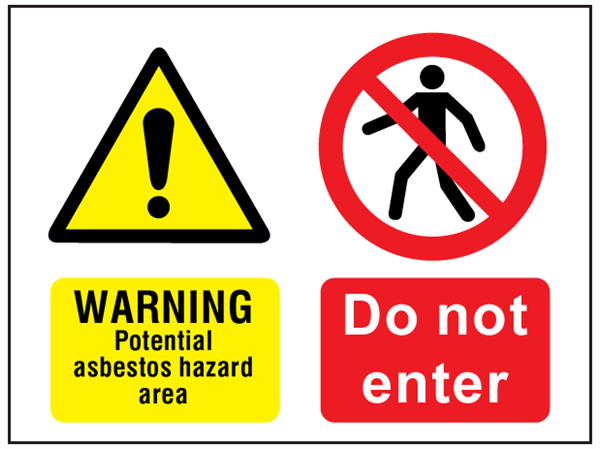
Digital Fire and Security was brought before Dungannon crown court in Northen Ireland, after being contracted to install a new fire alarm system. Digital Fire and Security failed to request a copy of an asbestos management plan before commencing their work. This negligence led to employees cutting though an asbestos insulation board ceiling during installation and was exposed to the lethal asbestos. Digital Fire and Security was ultimately fined £1000, plus £800 costs.
To ensure that this does not happen to your business, we, at label source, have taken the time to outline exactly what asbestos is, illnesses caused by exposure to asbestos and What needs to be included in your asbestos managemant plan.
What is asbestos?
Asbestos is a fibrous material which was regularly used in buildings until recently (1999). Asbestos was generally used as a means of fireproofing and insulating building, and many companies used asbestos in ceiling tiles, boilers, roof tiles, and pipe insulations.
There are 3 different types of asbestos;
Chrysotile, widely known as white asbestos. Chrysotile can resist high temperatures making it an ideal material for insulation and fireproofing. It was this type of asbestos which became banned in 1999.
Amosite, known as brown Asbestos was banned in 1986. Amosite was primarily used in the manufacture of insulation and anti-condensation products. Records indicate that 5% of all asbestos used in buildings before 1986 was of the amosite variety.
Crocidolite is commonly known as Blue asbestos. Crocidolite forms natural bundles of long, straight sharp needles making it exceptionally easy to inhale, making Crocidolite the most hazardous form of asbestos. Unlike Chrysotile and Amosite, Crocidolite is not heat resistant, therefor it was used less in the construction of buildings, it is recorded that on 4% of buildings built before 1980 contain Crocidolite asbestos. Because of the lack of heat resistance, Crocidolite was added into cement to increase its strength and durability.
Where can you find asbestos?
Asbestos can be found in industrial and residential buildings built or refurbished before 1999. Asbestos was used in many common building materials such as:
Cement, Ceiling tiles, Boilers, Pipes , Vinyl tiles, Fire blankets, Panels, Gutters, Roof tiles and Wall Panels to name a few.
Illnesses caused by asbestos
Asbestos fibres are fatal when inhaled and is known to cause serious lung diseases listed below:
Mesothelioma - Mesothelioma is a type of cancer that affects the pleura (lining of the lungs), and your lining of the lower digestive tract. Inhaling asbestos fibres cases them to get lodged in the lining of your lungs, causing irritation to the pleura, increasing the possibility of causing mutations that can lead to growth of cancer.
Mesothelioma is almost exclusively related to asbestos exposure, and is extremely hard to diagnose. By the time mesothelioma is diagnosed it is almost certainly fatal.
Asbestos related lung cancer - When someone inhales asbestos, the fibres can get lodged in the lining of their lungs. Once lodged these fibres cause enough irritation and cell damage they can generate tumours.
Researchers reported that 3mm fibres of asbestos are more likely to get lodged in the lining of your lungs whereas 5mm fibres are more likely to get lodges in the lungs tissue, increasing the risk of developing asbestos related lung cancer.
Asbestosis - Asbestosis occurs after many years of exposure to asbestos. This condition’s characteristics are serious scarring of the lungs, which can cause shortness of breath. In severe cases this can be fatal – if you have been exposed to asbestos in the past and are experiencing this you should contact your doctor as soon as possible.
Pleural thickening - Like Asbestosis, pleural thickening occurs after heavy or prolonged exposure to asbestos. Pleural is the lining of the lungs, is asbestos is inhaled this can cause the lining of your lungs to swell; this can cause extreme discomfort and shortness of breath.
Abestos management plan
If you are managing or are in control of non – domestic premises you have a duty to identify and locate all materials that potentially contain asbestos. This information should be stored in an asbestos management plan and should be passed on to anyone who is contracted to work on the building.
This plan should contain a floor plan outlining the areas that contain asbestos, an asbestos action plan (what work is going to be carried by who and when) and a communication plan, including the placement of warning signs.
If you have been asked to carry out maintenance, refurbishment or installations on a commercial building, those responsible for the work, project manager or company should ask for a copy of the management plan before commencing their work.
To avoid being fined please ensure that you are keeping you employees safe where there is a risk of potentially being exposed to asbestos.
If you manage a non domestic premises and are devising an asbestos management plan, then make sure you view our vast range of asbestos signs, labels and tapes, and clearly highlight areas of potential risk.